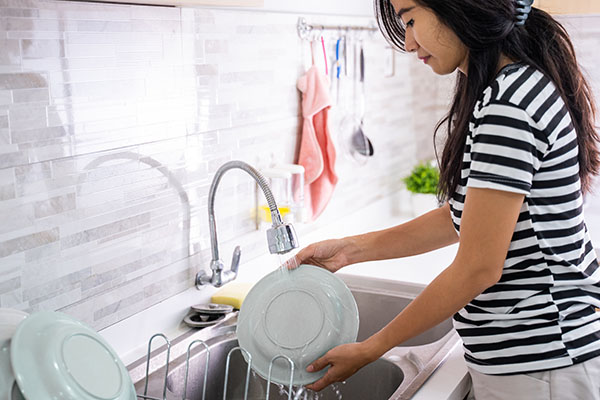A Consumer's Guide to Water Conservation

Water is our most precious resource. To be able to continue to take advantage of water for its important uses, it must be used efficiently. When Ohioans use less water to accomplish the same things, it will save money and help ensure a water supply is available for the future. The Office of the Ohio Consumers’ Counsel offers the following tips to help consumers efficiently use their water.
Droughts occur across the country every year, which puts water supplies at serious risk. Using water efficiently helps maintain our reserves.
Conserving water indoors
The United States Environmental Protection Agency (EPA) estimates each American uses about 82 gallons of water each day. Here is how our daily water usage breaks down:
- Toilets use the most water representing 18.5 gallons per person.
- Washing machines utilize anywhere from 7-18 gallons per load.
- A ten-minute shower uses up to 20-25 gallons of water.
- A half-full bath consumes about 30 gallons of water.
- Hygiene (washing face, brushing teeth, etc.) uses about 3 gallons.
- Dishwashers consume 4-15 gallons each cycle.
The EPA has developed the WaterSense program that strives to use water more efficiently. WaterSense labelled products are 20 percent more water-efficient and perform as well or better than standard models. The average household can save hundreds of dollars a year by replacing old products with WaterSense labeled models in their home. For more information on this program visit www.epa.gov/watersense.
Toilet
- WaterSense labeled toilets use as little as 1.28 gallons per flush. Replacing a toilet prior to 1980 with an efficient model can save up to about 13,000 gallons of water per year and more than $110 in water bills.
- Locate and fix leaks. A leaking toilet can waste as much as 200 gallons each day. An easy way to test a toilet for leaks is to place 10 drops of food coloring into the tank. Wait 15 minutes and then check the bowl. If the colored water shows up, there is a leak.
Shower & Bath
- WaterSense labeled shower heads use no more than 2.0 gallons of water per minute and can save the household up to 2,700 gallons of water per year.
- To find out whether showering or taking a bath uses more water, plug the drain while showering. Compare the final water level to the normal bath water level. Typically, a partially filled tub is equal to a short shower.
- Take shorter showers to help conserve water. Try playing a song that matches the target shower time.
Sink and Other Household Fixtures
- Make sure all faucets have an aerated or spray tap. Aerators mix air with the water to cut down on water use. WaterSense labeled bathroom sink faucets use a maximum of 1.5 gallons per minute and can reduce water flow by 30 percent or more. Replacing old faucets and aerators can save up to 700 gallons of water per year.
- Turning off the water while brushing teeth will save up to eight gallons of water per day.
- When shaving, plug up the sink and run enough water to rinse the razor instead of using running water.
- Make it a habit to fix faucet leaks promptly. Leaky faucets often require new washers or gaskets. A leaky faucet can waste over 3,000 gallons of water a year.
- Strive to wash only full loads of laundry. If smaller loads of laundry are necessary, adjust the water level on the washing machine accordingly. Use cold water when possible.
- Waiting to run the dishwasher until it is full can save nearly 320 gallons of water annually.
Conserving water outdoors
- In the summer, watering lawns and gardens can more than double Ohioans’ monthly water usage.
- Consider watering in the cooler morning hours to minimize evaporation.
- Adjust the watering schedule according to the weather. Let Mother Nature water the lawn.
- Ideally, use a rain barrel. Collecting rainwater is a free way to water the plants and wash the car.
- Promptly repair any leaky hoses or spigots. And make sure the sprinkler hits plants not the sidewalk.
- When purchasing new trees and plants, look for those which require less water to survive. Native plants usually require little water beyond normal rainfall.
- Use a broom instead of a hose to clean the driveway and sidewalk.
- Turn the hose off while washing the car.
- Mulch flower beds to keep the soil cool, reduce moisture evaporation, and promote growth.
To download: Click the folder with a down arrow icon. To print: Click the printer icon in the top right of the display.
If you need multiple copies for an organization or group, please contact a member of our outreach team.
